Check Out 2021’s Best Milky Way Photography and Enjoy the Beauty of Our Galaxy
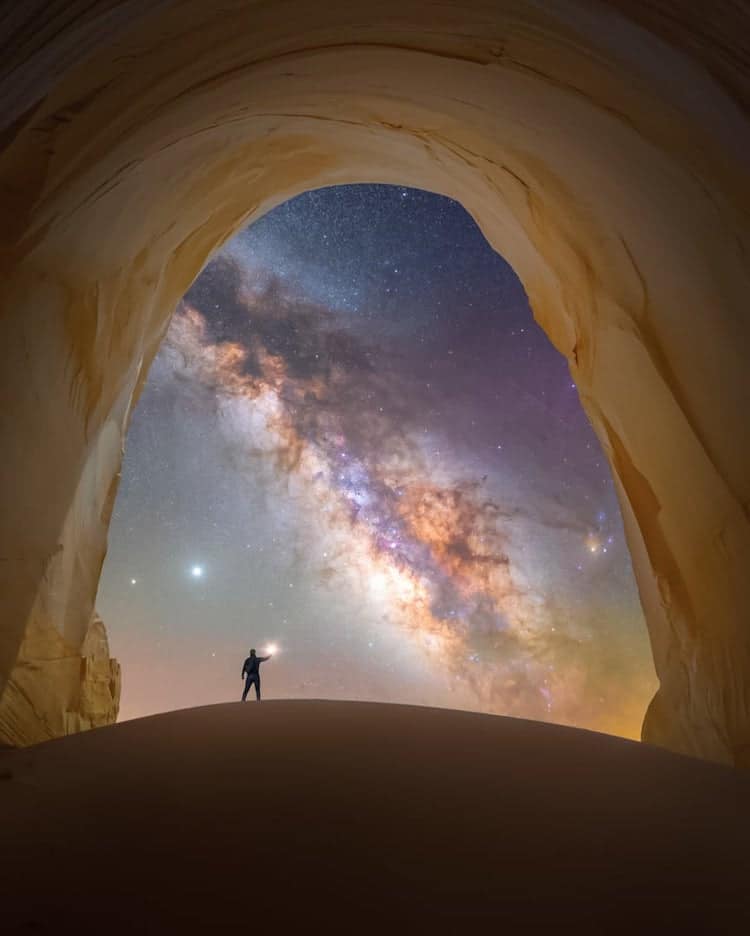
“Chamber of light” by Spencer Welling. Utah, USA.
“The deserts of the Southwest are abound with places to capture the night sky. With all that the Southwest has to offer, it’s easy to overlook some of the more obscure hidden gems hovering under the radar.
This is one such location, which is situated below a remote set of cliffs in Grand Staircase-Escalante. Due to its remoteness, this natural stone chamber provides some of the clearest, most pristine views of the Milky Way framed by the copper-colored opening of the cavern.”
A sight to behold, the Milky Way has long been a source of fascination for photographers. And each year, Capture the Atlas, run by photographer Dan Zafra, pays homage to our galaxy by curating the best photos from its community of over 20,000 photographers. The list is an inspiring look at the night sky and the Milky Way around the globe.
This year's best Milky Way photographs take us to the deserts of the American Southwest, the Persian Gulf Coast, the national parks of Indonesia, and the Australian Outback. The gallery is a unique look at how the Milky Way is experienced in both hemispheres and offers an incredible view into the creativity of the photographers. While the brilliant galaxy is always the star of the show, seeing it placed in different contexts also highlights these incredible landscapes.
Each photographer has also shared a bit about their experience in creating the photograph. Capturing the Milky Way takes time, research, and technical know-how. By taking us behind the image, these photographers bring us along on their journeys. If their stellar work has you wondering how to take your own photo of the Milky Way, Capture the Atlas has a special guide to help.
Check out some of the best Milky Way photos of 2021 from Capture the Atlas.
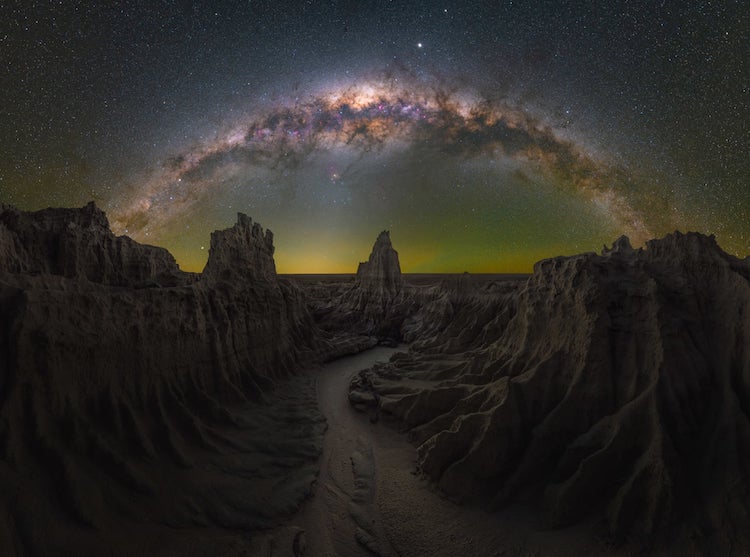
“Dragon’s Lair” by Daniel Thomas Gum. Mungo, NSW, Australia.
“This is my favorite nightscape image to date. Mungo is a 12-hour drive away from my home in Sydney, but those Bortle 1 skies are the best I’ve ever witnessed and photographed at night. I had perfect conditions for three straight nights, with really good seeing throughout.
The moment I came upon this scene, I knew exactly what I wanted to name the image. It was otherworldly – think Game of Thrones – and it lined up perfectly for how I wanted to capture it. Large, jagged walls framed a winding path leading to a centered spire to the west. There was only ever going to be one way to do it justice and that was as a multi-layered Milky Way panorama.
I planned this image using PhotoPills during the day, but in post-processing, I decided to use the blue-hour blend for the foreground with a tracked sky for the cleanest possible image.”

“Devil’s throat” by Victor Lima. Iguazu Falls, Brazil.
“Photographing Iguazu Falls at night has always been one of my priority projects. In order to do so, I needed to obtain special authorization from the environmental agency that is responsible for national parks in Brazil.
Finally, in early 2021, I got this authorization and set out to put my plan into practice. I spent 4 days inside the Iguazu National Park with exclusive access to the Falls at night for my students and me. The first challenge was to walk around the park at night knowing that several jaguars live there, which are frequently seen by employees and tourists.
In the area closest to the main waterfalls, the big challenge was to make long exposure images with the strong water spray from the more than 1.5 million liters per second that fall through the waterfalls. Working with exposure times longer than 10 or 15 seconds became an almost impossible task and the lens was never dry.
In this image, we have one of the main waterfalls of the Iguazu Falls complex, the “Santa Maria Jump.” Right over the fall, we can see Saturn and the zodiacal light illuminating the horizon. Further up there is the Milky Way Core. We can also identify some of the main emission nebulae present in this region of the sky.”

“Paradise” by Marcin Zajac. Bur Sur, California, USA.
“If I had to choose my favorite place on earth, this might be it. Located on the Pacific Coast near Big Sur, it really has everything: a beautiful cove filled with emerald waters, an 80-foot waterfall that falls directly onto the beach, a palm tree that makes you feel like you’re on a tropical island, and a perfectly dark sky that shines bright with stars at night.”
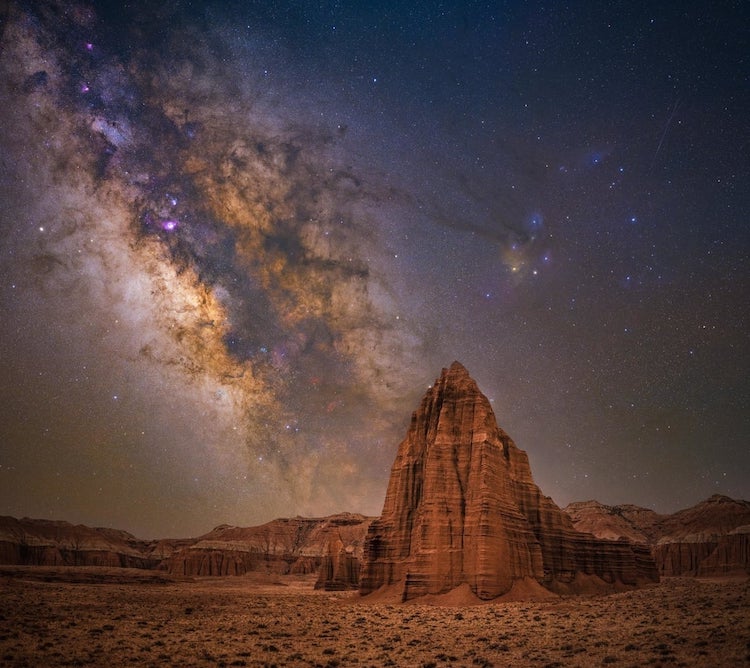
“Temple of the sun” by Bryony Richards. Capitol Reef National Park, Utah, USA.
“The Milky Way core rises before dawn under the southern skies of Capitol Reef National Park’s “Temple of the Sun.” This area of the Colorado Plateau Desert, known for its domes, hoodoos, fins, reefs, natural bridges, and slot canyons, includes the Temples of the Sun and Moon.
These Jurassic-aged sandstone monoliths, which formed as sandy mud on a tidal flat, tower above the otherwise flat desert floor. It seems like more than a coincidence that the Temples line up perfectly with the Milky Way, their vibrant orange colors seemingly reflecting the color of the stars above.”
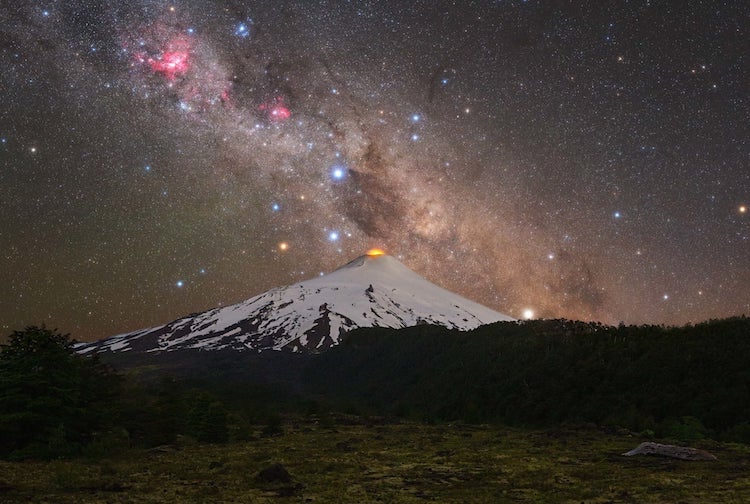
“Volcano and cross” by Tomas Slovinsky. Villarrica Volcano, Chile.
“If you’ve never seen the Southern Sky, it’s significantly different and truly amazing. In the Northern Hemisphere, we use Polaris as the polar star, but below the equator, there are other rules. To easily recognize the south celestial pole, the best indicator is the Southern Cross constellation, located in the image just above the Villarrica volcano.
This cross points to the south celestial pole and it’s easy to identify, considering the brightness of the stars. Within the cross, we can see the dark area called “the Coalsack,” which is also visible to the naked eye. It’s one of the best-known dark nebulae in the sky.
In the upper left corner, there’s another night sky gem: the red-colored Carina Nebula. This is also only visible in the Southern Hemisphere and, even though it’s visible to the naked eye, with a pair of binoculars, we can see all the beautiful details.”
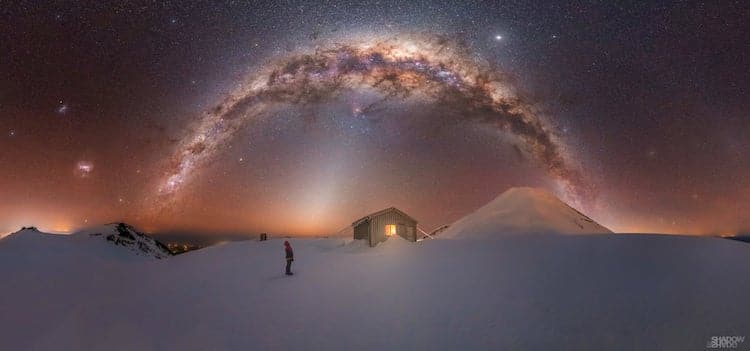
“Mt. Taranaki Milky Way” by Larryn Rae. Fanthams Peak, Mt. Taranaki, New Zealand.
“This is one of the most challenging shots I have ever captured, as it required climbing for 4 hours in 70km/h winds to reach the ice summit of Fanthams Peak – a volcano on the side of Mt Taranaki. At an elevation of 2000 m and -15ºC outside with gusty wind blasts, I had to choose settings that would get me the capture rather than what I may have considered more ideal settings.
I am so stoked to have captured what I did under perfectly clear skies, as it was both a true test of both mountaineering and endurance carrying all my gear to this location, but one I will look back on with pride and success.”
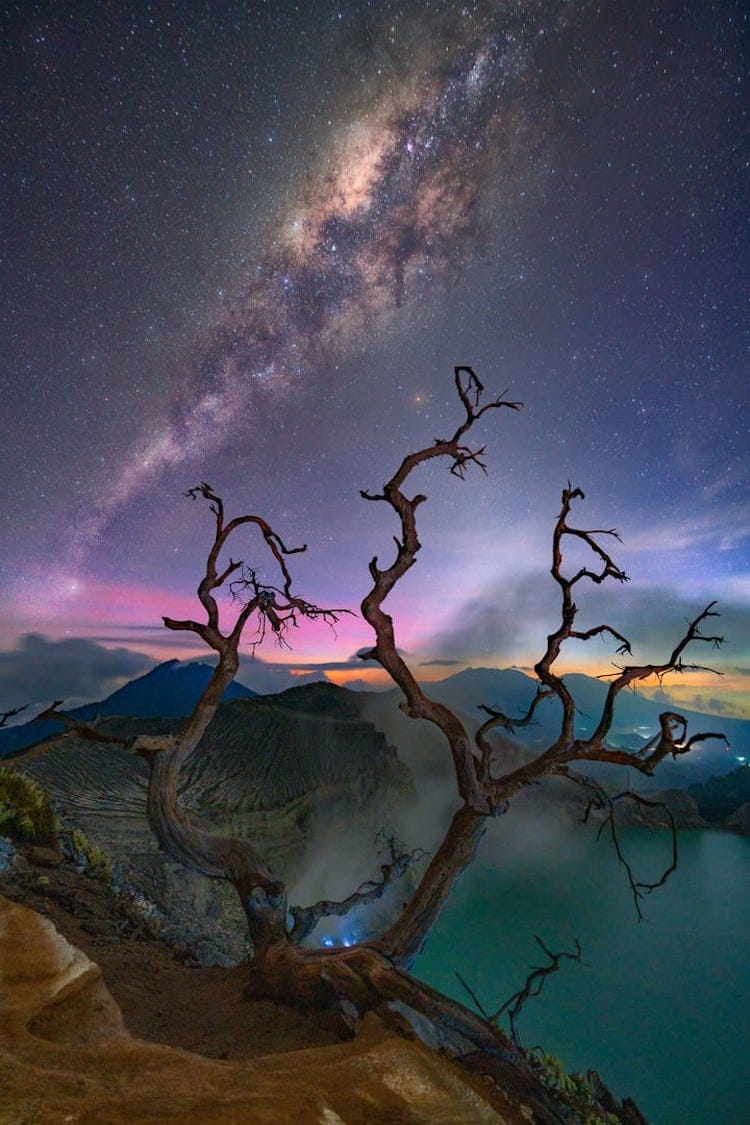
“Around dead trees” by Gary Bhaztara. Java, Indonesia.
“I took this shot of the Milky Way facing south after the sunset in the west. At the same time, the blue fire was burning just below the mountain while the Milky Way kept rising.
Taking the picture at this spot was a bit difficult because of health reasons and the National Parks schedule. It’s prohibited to stay there after midnight, so I didn’t have much time to take more images. This trip was a struggle because of the many challenges but I love every single corner of the Ijen Crater; it’s like a piece of heaven on earth.”
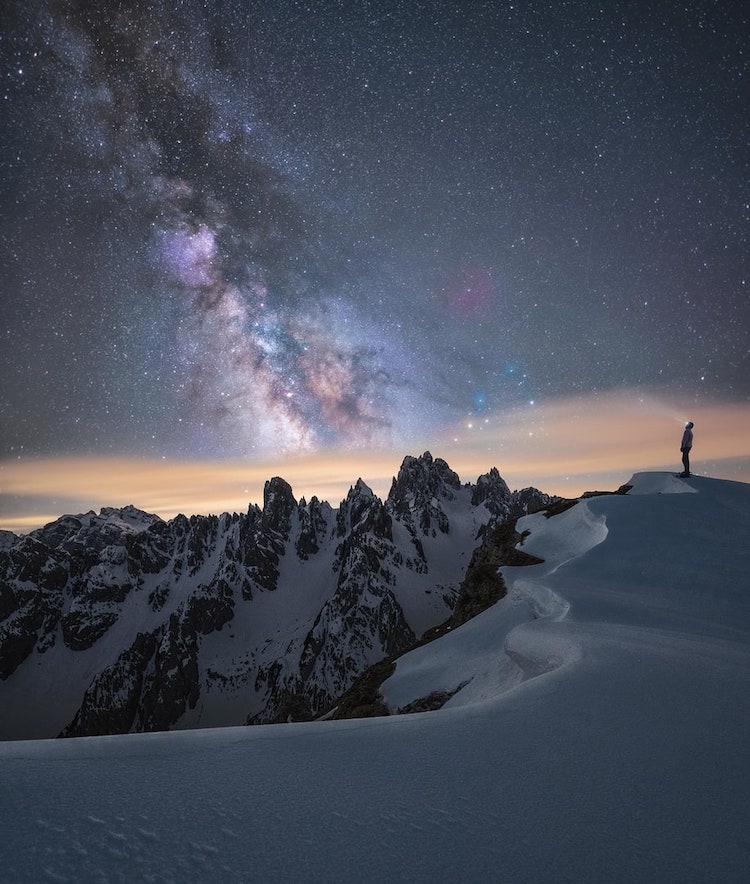
“Cadini di Misurina” by Stefano Pellegrini. Cadini di Misurina, Dolomites, Italy.
“This was from a great Milky Way trip in the Italian Dolomites, although there were some challenges because of the weather. First of all, I took this picture in May when the snow had almost melted, so I had to make the ascent to “Auronzo” on foot instead of by snowmobile. Also, the path was hard because I had to walk it in the middle of a heavy snowstorm.
Fortunately, once I was at the top, the sky completely opened, a good sign for the night shooting. After a brief rest in the winter shelter, I started the hike to this spectacular location at midnight. Once I was at the spot, the compositional possibilities were very limited. This place, which is very popular during the summer, was completely different covered in snow. The whole ridge was covered in a 3-meter coat of puffy snow that made it very dangerous to get too close to the edge. I placed the camera as close as possible to the rim to capture the mountain range, and then I moved all the way up to the right to complete the shoot with myself.”
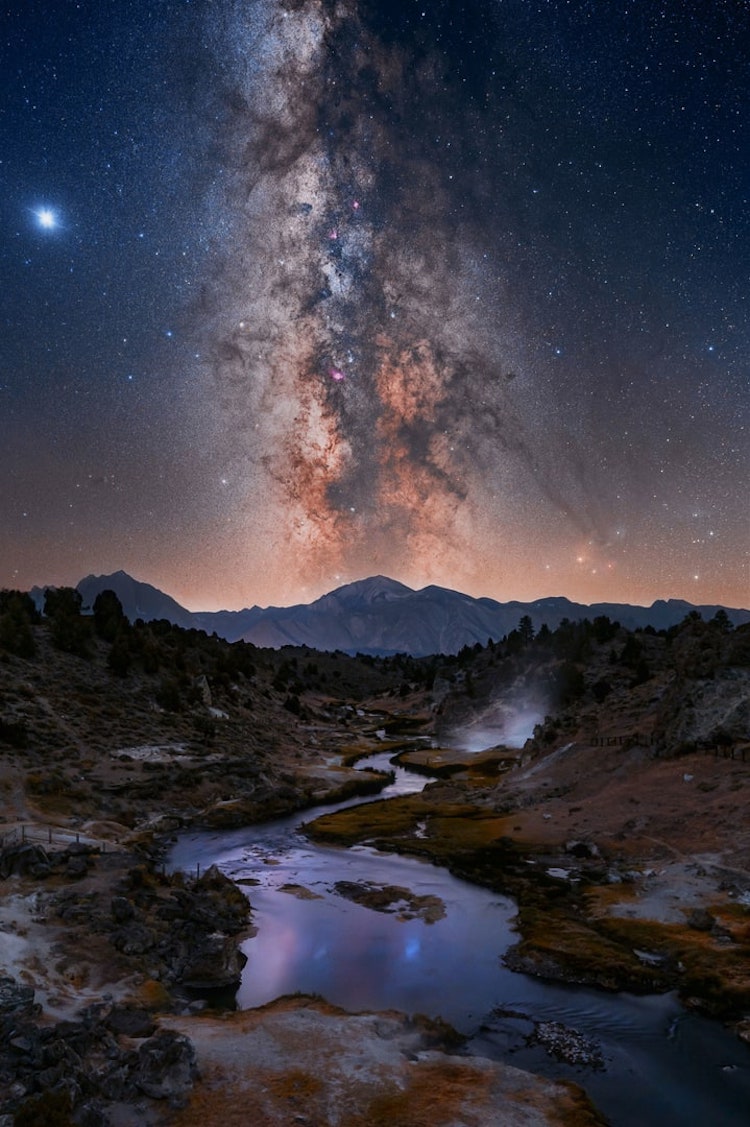
“When all the stars align” by Kelly Teich. Mammoth Lakes, California, USA.
“Some of the darkest skies in California are along Hwy 395 on the eastern side of the Sierras. This particular location, near Mammoth Lakes, is a unique spot where the vertical alignment of the Milky Way’s Galactic Core sits perfectly over a mountain peak and a creek with natural hot springs flowing into it.
You really couldn’t ask for a better foreground to work with! This image was taken in July, so I had to wait until a little past midnight for the proper alignment to begin shooting. Rather than going fully wide angle at 16mm, I zoomed in a little to 24mm, so the Milky Way took up more of the frame and I could capture only the most interesting area of the foreground. The sky was shot first using a star tracker. Then, I turned off the tracker and shot the foreground using the same camera settings. A simple post-processing blend of the two (sky and foreground) completed the image.”
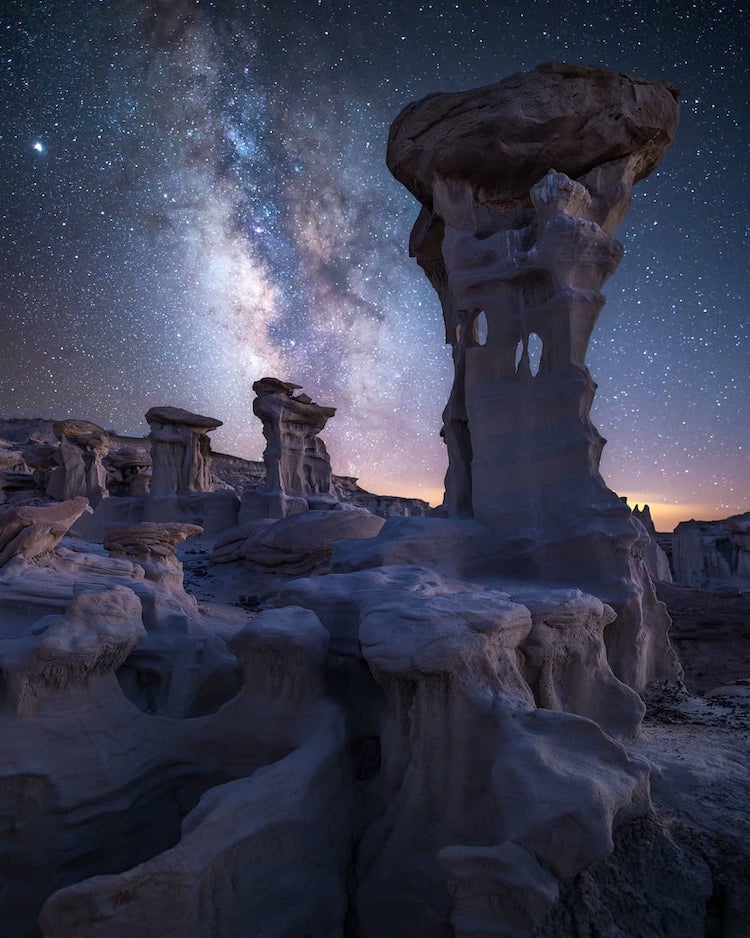
“Navajo nights” by Christine Kenyon. Bisti Badlands, New Mexico, USA.
“The mountainous West is awash in beauty, culture, history, and tradition, and sites like this, in the Bisti Badlands, are treasures to behold and cherish. Arriving before sunset, I encountered several other photographers occupying the position best known as the classic shot of this place.
In no way ruffled, I scouted the area, as I normally do, looking intently for compelling compositions. When I saw this scene and verified with the PhotoPills app that the Milky Way core would perfectly align with the rock feature, I was hooked.
With the silhouette of my Navajo guide nearby, I shot the foreground as blue hour washed over this ancient land, then watched with joy as the stars coursed through the heavens above. When the Milky Way rose into prominence and settled where I had hoped, I exposed for the sky to complete this blend.
Always remember that. while these are amazing natural wonders, these sites hold far greater significance for the Navajo people. Let us all protect and cherish these lands for generations to come. If I could leave you with just one piece of advice, it would be: always scout for your own compositions. Be a photographer, not a photocopier.”
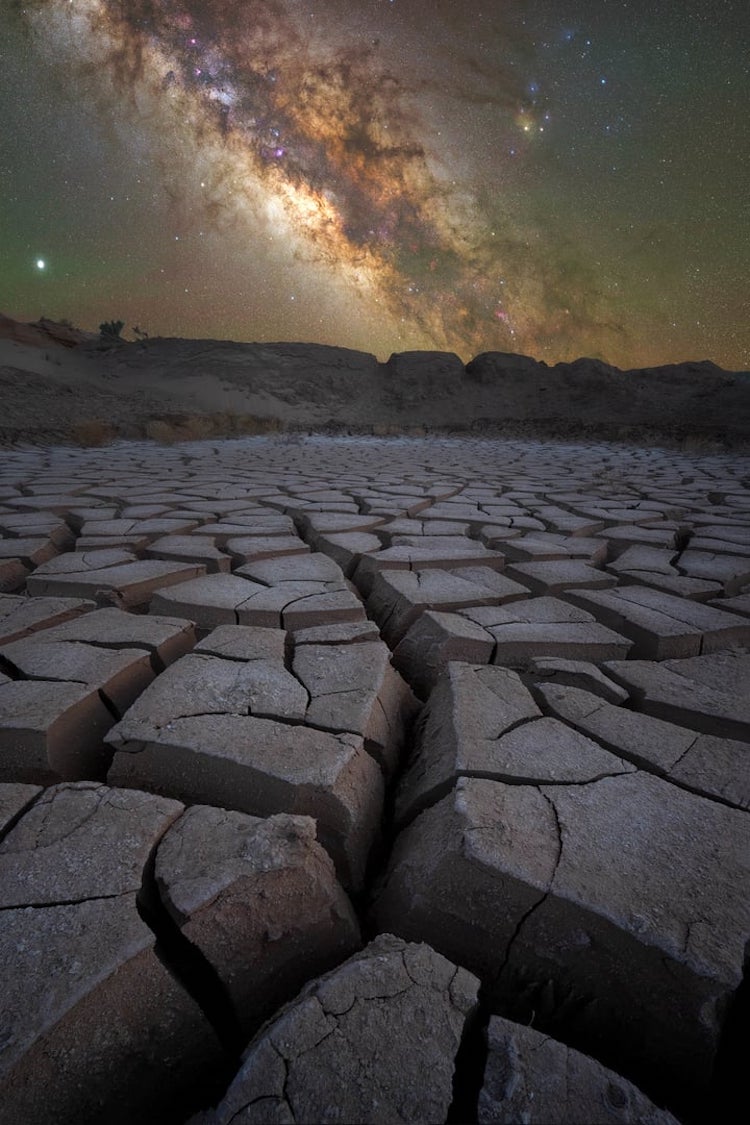
“Desolation” by Phil Sisto. Capitol Reef National Park, Utah, USA.
“Utah is a place that captured my heart from the beginning of my journey as a Milky Way photographer. Living in the light-polluted Midwest (I’m located in northeast Ohio), it takes three to four hours of driving from my home to arrive at any place where you can get an even satisfactory look at the stars. Because of this, I make my way out West every summer now, seeking out the darkest skies and most epic locations I can find to do photography.
When I learned that Capitol Reef—arguably the darkest national park in Utah—offered a residency program for its selected artist where I could live and work under those incredible skies for an entire month, I put together a portfolio of the best work I had and an ambitious program proposal…and got accepted! This image was captured in the remote Cathedral Valley District of the park. I placed my camera low to the ground, exaggerating the otherworldly mud cracks with my wide-angle lens, and shot the sky with a longer lens as a panorama on my star tracker.”
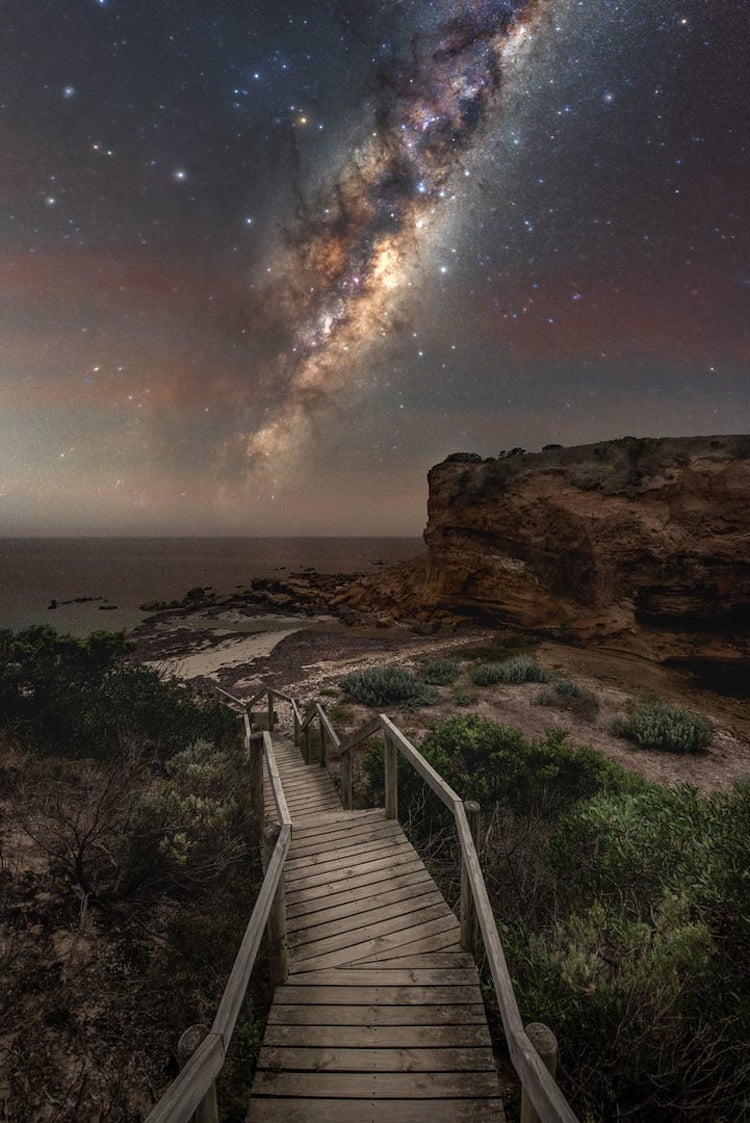
“The Forgotten side of Kangaroo Island” by Blntpencil. Baudin Beach, Kangaroo Island, Australia.
“This image was captured at Baudin Beach on Kangaroo Island. This part of the island was luckily not affected by the devastating bushfires in 2020. It is a capture of the rising Galactic Center floating above the ocean and represents the way of life on the island ‘where people live at one with nature.'”

“Riaño” by Pablo Ruiz. Riaño, Spain.
“I captured this image last winter in the Riaño Mountain Reservoir in Spain. The biggest difficulty that night was mainly the cold; it was over -10 degrees. The moisture in the reservoir was freezing the lens and it was difficult to shoot for a long period of time.
I planned the photograph using PhotoPills and, when the weather forecast was promising, I decided to try for it. The composition of the winter Milky Way over the mountains and the reservoir created magical scenery.”
Capture The Atlas: Website | Instagram | Facebook | Twitter | YouTube
My Modern Met granted permission to feature photos by Capture the Atlas.
Related Articles:
The Best Milky Way Photographers of the Year Show the Beauty of Our Galaxy
Photographer Captures Sight of a Rare Comet That Only Appears Every 6,800 Years
Most Enchanting Aurora Borealis Photos From the Northern Lights Photographer of the Year Contest
READ: Check Out 2021’s Best Milky Way Photography and Enjoy the Beauty of Our Galaxy
0 Commentaires